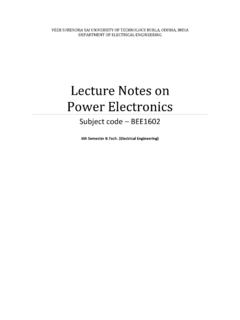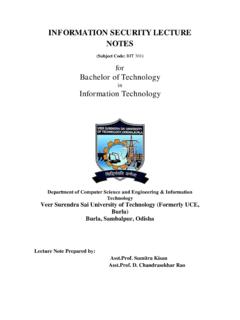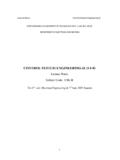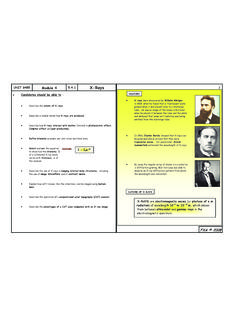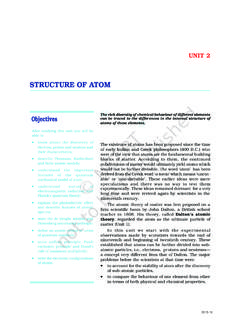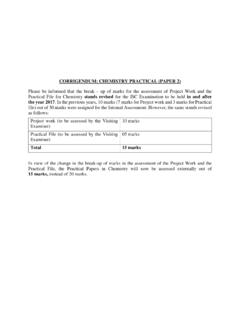Transcription of EEM LECTURE NOTES - Veer Surendra Sai University …
1 ELECTRICAL ENGINEERING MATERIAL LECTURE NOTES for Bachelor of Technology in Electrical Engineering & Electrical and Electronics Engineering Department of EE & EEE Veer Surendra Sai University of Technology (Formerly UCE, Burla) Burla, Sambalpur, Odisha LECTURE Note Prepared by: Prof. Ramesh Chandra Prusty SYLLABUS ELECTRICAL ENGINEERING MATERIALS (3-1-0) Credit-04 MODULE-I (10 HOURS) Conductivity of Metal: Introduction, factors affecting the resistivity of electrical materials, motion of an electron in an electric field, Equation of motion of an electron, current carried by electrons, mobility, energy levels of a molecule, emission of electrons from metals, thermionic emission, photo electric emission, field emission, effect of temperature on electrical conductivity of metals, electrical conducting materials, thermal properties, thermal conductivity of metals, thermoelectric effects.
2 MODULE-II (10 HOURS) Dielectric Properties: Introduction, effect of a dielectric on the behavior of a capacitor, polarization, the dielectric constant of monatomic gases, frequency dependence of permittivity, dielectric losses, significance of the loss tangent, dipolar relaxation, frequency and temperature dependence of the dielectric constant, dielectric properties of polymeric system, ionic conductivity in insulators, insulating materials, ferroelectricity, piezoelectricity. MODULE-III (10 HOURS) Magnetic properties of Materials: Introduction, Classification of magnetic materials, diamagnetism, paramagnetism, ferromagnetism, magnetization curve, the hysteresis loop, factors affecting permeability and hysteresis loss, common magnetic materials, magnetic resonance.
3 MODULE-IV (10 HOURS) Semiconductors: energy band in solids, conductors, semiconductors and insulators, types of semiconductors, Intrinsic semiconductors, impurity type semiconductor, diffusion, the Einstein relation, hall effect, thermal conductivity of semiconductors, electrical conductivity of doped materials. BOOKS [1] and S. Thiruvengadam, S., An Introduction to Electrical Engineerin [2] Kenneth G. Budinski,, Engineering Materials: Prentice Hall of India, New Delhi MODULE-I CONDUCTIVITY OF METALS INTRODUCTION: The most important properties of metals are their high thermal and electrical conductivities. Silver has the highest electrical conductivity.
4 Copper comes next and is similar to silver from the point of view of atomic structure ; both belonging to the same group of periodic table. The conductivity of copper is less than that of silver. Since supplies of copper are not abundant in nature, aluminium which is light and has a high conductivity is rapidly becoming more important as a conductor material. Gold which has a conductivity higher than that of aluminium but lower than that of silver or copper does not find use in electrical industry because it is expensive. Metals having complex structures such as As, Sb, Bi, Sn, Hg have lower conductivities which lie between those of ideal metal (very high conductivity) and of insulators (negligible conductivities).
5 FACTORS AFFECTING THE RESISTIVITY OF ELECTRICAL MATERIALS 1. Temperature : The electrical resistance of most metals increases with increase of temperature while those of semiconductors and electrolytes decreases with increase of temperature. Many metals have vanishing resistivity at absolute zero of temperature which is known as superconductivity. 2. Alloying : A solid solution has a less regular structure than a pure metal. Consequently, the electrical conductivity of a solid solution alloy drops off rapidly with increased alloy content. The addition of small amount of impurities leads to considerable increase in resistivity. 3. Cold Work : Mechanical distortion of the crystal structure decrease the conductivity of a metal because the localized strains interfere with electron movement.
6 4. Age Hardening : It increases the resistivity of an alloy. MOTION OF AN ELECTRON IN AN ELECTRIC FIELD In a conductor, the electrons are moving about with random velocity , the magnitude of which depends upon the temperature. There are two comonents of motion, as follows : 1. Random motion , due to thermal effects. 2. Directed motion , the direction being determined by the polarity of the electric field. EQUATION OF MOTION OF AN ELECTRON When no electric force is applied , the free electrons move about through the conductor in a random manner in such a way that the number of electrons moving from right to left is the same as the number moving from left to right and the resultant current is nil.
7 If an electric force is applied to the conductor, each electron has superposed on to its random motion, a motion impressed on it by electric force, and the electrons as a whole are driven through the conductor by the continued action of this electric force. THE CURRENT CARRIED BY ELECTRONS In a current carrying conductor, the electrons drift along with an average velocity which is generally small compared with their random velocity due to thermal agitation. Let a current I be carried along a conductor of cross section A by electrons of charge -e and of average drift velocity v. In time dt the electrons will travel a distance vdt and the number of electrons crossing any cross section A in time dt will be the number contained in the volume Avdt.
8 Thus if there are N electrons per unit volume of the conductor the total charge flowing through the section in time dt is dq= I=dq/dt= -eNAv And current density I/A= -e Nv = +e2 NEt/m Since, v= -eEt/m The expression for current density shows that the current density does not depend on the size of the conductor. It is a general property of the material. Finally, the current density is proportional to the electric field strength and the constant of proportionality e2Nt/m is called conductivity of the material and is denoted by = e2Nt/m . Ohm s law follows as an immediate consequence of the relation J= c ; because I= = = ( V/l).A Where l is the length of conductor and V is the voltage applied to the conductor ends.
9 Since A/l=R where R is the resistance of the conductor. MOBILITY : It has been noted that the average drift velocity of the electrons in an applied field is proportional to the field , the absolute magnitude of the proportionality factor et/m, being called the mobility of the electrons which is denoted by u. The mobility may thus be defined as the magnitude of average drift velocity per unit field. The mobility and the conductivity are related by the equation = NeU. Thus the mobility of the electrons can be determined by knowing the conductivity of the material and estimating the number of free electrons. Mobility, U= /Ne = 1/ Ne =1/( = m2/volts-sec . The order of magnitude of collision time for copper atoms may be determined from the relation t=m/Ne2.)
10 In the absence of an electric field no electric current is observed in the conductor. When an electric field is applied to the conductor the electrons moving in the direction of the electric force acting on them retarded. Thus the movement of electrons in the direction of the field force predominates over that which proceeds in the opposite direction, the result being an electric current. Taking account of fact that only quantum states of motion are possible for electrons, the acceleration may be conceived as the transfer of an electron into a new quantum state of greater velocity and the deceleration as the transfer of an electron into a state of less velocity.



